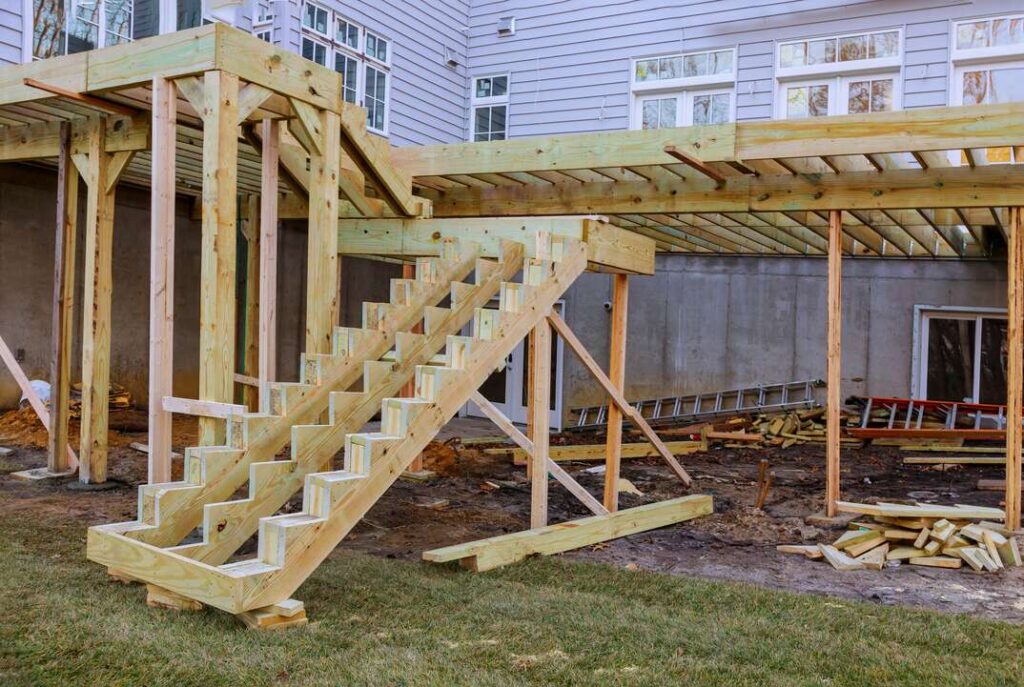Welcome to your comprehensive guide on deck construction! Whether you’re considering adding a deck to your home for leisure, utility, or aesthetic purposes, this guide will walk you through every step of the process. From planning and designing to building and maintaining, let’s dive into everything you need to know about deck construction.
Planning Your Deck Construction
Understanding Local Building Codes and Permits
Before embarking on your deck construction journey, it’s crucial to understand local building codes and secure the necessary permits. These regulations ensure your deck is safe and compliant, avoiding costly fines and modifications later on.
Choosing the Right Location for Your Deck
Select a location that enhances your home’s layout and maximizes outdoor living space. Consider factors like sun exposure, privacy, and proximity to natural elements when deciding where your deck should go.
Deciding on the Size and Shape of Your Deck
The size and shape of your deck should complement the design of your house and the available yard space. Plan for enough space for gatherings, perhaps with designated areas for dining, lounging, or cooking.
Designing Your Deck
Popular Deck Designs and Trends
Explore current trends in deck construction, such as multi-level decks, built-in seating, and eco-friendly materials. Incorporating modern designs can increase the functionality and value of your home.
Materials to Consider for Deck Construction
From traditional woods like cedar and redwood to modern composites, your choice of materials impacts both the appearance and longevity of your deck. Each material offers different benefits in terms of durability and maintenance.
Incorporating Accessibility in Deck Design
Ensure your deck is accessible to everyone, including those with limited mobility. Consider features like wider doorways, ramps instead of stairs, and low-threshold doors.
Budgeting for Deck Construction
Estimating the Costs Associated with Deck Building
Deck construction can vary widely in cost depending on size, materials, and design complexity. Prepare a detailed budget that includes costs for materials, labor, and any additional features like lighting or custom work.
Tips for Saving Money on Deck Construction
To save on costs, consider handling some tasks yourself, choosing more affordable materials, or simplifying the design. However, don’t compromise on structural integrity or safety to cut costs.
How to Budget for Maintenance and Upkeep
Factor in the long-term costs of maintenance and repairs in your budget. Different materials require different levels of upkeep, which can affect your overall financial planning.
Choosing the Right Materials
Comparing Wood, Composite, and PVC Decking
Wood offers a classic look but requires more maintenance. Composite and PVC materials are more durable and require less upkeep but come at a higher cost. Weigh the pros and cons based on your lifestyle and budget.
Pros and Cons of Different Decking Materials
Each decking material has its strengths and weaknesses. For instance, wood is susceptible to weathering and requires frequent staining, while composites are more resistant to rot and pests.
Longevity and Durability of Decking Materials
Consider the lifespan of your chosen materials. While initial costs may be higher for certain materials, their durability might offer savings in the long run.
The Deck Foundation
Types of Deck Foundations
Choose from ground-level, raised, or multi-level deck foundations based on your home’s geography and design. Each type supports different loads and integrates with varying land topographies.
Step-by-Step Guide to Building a Strong Foundation
A strong foundation is crucial for a durable deck. Follow detailed steps for digging post holes, setting posts, and laying the foundation to ensure stability and compliance with local codes.
Common Foundation Issues and How to Avoid Them
Prevent issues such as shifting and water damage by using appropriate materials and techniques, such as proper grading and waterproofing measures.
Deck Framing Basics
Understanding the Importance of Proper Framing
Framing is the backbone of your deck’s structure. A well-framed deck provides a solid base that ensures safety and longevity.
Materials Needed for Deck Framing
You’ll need pressure-treated lumber, joists, beams, and fasteners. Choosing high-quality materials can prevent problems such as warping and wood rot.
Common Framing Mistakes and How to Prevent Them
Avoid common errors like improper joist spacing or inadequate beam sizing by following local building codes and manufacturer instructions closely.
Installing Decking Boards
Choosing the Direction and Pattern of Boards
The orientation and pattern of your decking boards can affect both the appearance and integrity of the deck. Consider visual appeal and structural support when deciding how to lay the boards.
Tips for Cutting and Installing Boards
Use the right tools and techniques to cut and install decking boards for a smooth, professional finish. Ensure each board is securely attached and free of splinters or rough edges.
Ensuring Proper Spacing and Alignment
Proper spacing allows for wood expansion and water drainage, while alignment affects the overall look of the deck. Use spacers and check alignment regularly during installation to prevent issues.
Adding Railings and Stairs
Designing Safe and Stylish Railings
Railings add safety and style to your deck. Choose a design that complements your home’s exterior and meets safety standards.
Step-by-Step Guide to Building Deck Stairs
If your deck is raised, you’ll need stairs for access. Ensure they are sturdy and comply with local codes for riser height and tread depth.
Material Options for Railings and Stairs
Materials like wood, composite, and metal can vary in aesthetics, cost, and maintenance. Match these to your decking for a cohesive look.
Deck Lighting and Electrical Considerations
Planning for Lighting and Electrical Outlets
Proper lighting enhances the usability and ambiance of your deck after dark. Plan for integrated lighting and outdoor electrical outlets during the initial design phase.
Types of Deck Lighting to Enhance Your Space
Choose from ambient, task, or accent lighting to create the desired atmosphere. Solar-powered lights are a popular, energy-efficient option.
Safety Tips for Electrical Installations
Ensure all electrical installations are done by a qualified professional and comply with electrical safety codes. Use weather-resistant materials and fixtures to prevent hazards.
Finishing and Waterproofing
Options for Staining and Sealing Your Deck
Protect and enhance the appearance of your wood deck with stains and sealants. Choose products that offer UV protection and moisture resistance.
Best Practices for Deck Waterproofing
Waterproofing is essential for preserving your deck’s condition. Apply a waterproofing sealant and ensure proper drainage to avoid water accumulation.
Maintaining Your Deck’s Look and Durability
Regular maintenance such as cleaning, re-staining, and checking for wear and tear can extend your deck’s life and keep it looking great.
Deck Decor and Furnishing
Choosing Furniture and Accessories for Your Deck
Select outdoor furniture that is durable and complements your deck’s design. Consider weather-resistant materials and storage options for off-season months.
Ideas for Outdoor Kitchens and Bars on Decks
An outdoor kitchen or bar can make your deck the perfect spot for entertaining. Plan for utilities like water and gas, and choose suitable materials for outdoor use.
Incorporating Plants and Greenery
Plants can add color, privacy, and a relaxing vibe to your deck area. Choose species that thrive in your climate and require minimal upkeep.
Maintenance and Care for Your Deck
Routine Maintenance Tasks
Regular cleaning, inspecting for damage, and making necessary repairs are all crucial for keeping your deck in top condition.
How to Handle Common Deck Problems
Learn how to deal with issues such as loose boards, rotting wood, and peeling paint. Early detection and repair can save time and money.
When to Call a Professional for Deck Repair
While DIY maintenance is possible, some problems require professional attention. Don’t hesitate to call in experts for complex issues or structural repairs.
Frequently Asked Questions (FAQs)
1. How much does it cost to build a deck?
The cost of deck construction varies widely depending on factors such as the size of the deck, materials used, and regional labor costs. On average, prices can range from $15 to $35 per square foot for materials and labor.
2. Do I need a permit to build a deck?
In most cases, yes, you will need a permit to build a deck. Local building codes vary, so it’s important to check with your city or county’s building department to understand the specific requirements and obtain the necessary permits before starting construction.
3. How long does it take to build a deck?
The time it takes to build a deck can vary based on the complexity of the design, the materials chosen, and the availability of labor. Typically, a simple deck can be completed in one to three weeks, while more complex designs might take several weeks to a month.
4. What is the best material to use for a deck?
The best material for your deck depends on your budget, climate, and maintenance willingness. Common choices include pressure-treated wood, which is cost-effective and durable; cedar and redwood, which offer natural beauty and resistance to decay; and composite materials, which are more expensive but require less maintenance.
5. How do I maintain my deck?
Regular maintenance includes cleaning, checking for loose nails or screws, sanding and replacing worn or damaged boards, and applying a sealant or stain every few years to protect against weather damage. The specific maintenance routine can vary based on the material of your deck.
6. How can I ensure my deck is safe?
To ensure safety, make sure your deck is built according to local building codes, regularly check for any signs of wear or damage, ensure railings and stairs are secure, and maintain good condition of the deck surface to prevent slips and falls.
7. Can I build a deck myself or should I hire a professional?
Building a deck can be a DIY project if you have good carpentry skills and understand the local building codes. However, for complex designs or if you are not confident in your ability to build a safe and sturdy structure, it is recommended to hire a professional.
8. What are the trends in deck design?
Current trends in deck design include multi-level decks, built-in lighting, outdoor kitchens, and the use of eco-friendly materials. Integrating technology for outdoor entertainment and creating flexible spaces that can be used year-round are also popular.
9. How often should I replace my deck?
The lifespan of a deck depends on the materials used and how well it is maintained. A well-maintained wood deck might last 15 to 20 years, while composite decks can last 25 to 30 years or more. Regular inspections will help determine when it’s time to replace your deck.
10. Are there environmentally friendly decking options?
Yes, there are several environmentally friendly decking options available, including composite decking made from recycled materials and sustainably harvested wood options. Choosing eco-friendly materials can reduce environmental impact and often comes with the benefit of less maintenance.
Conclusion
Embarking on a deck construction project can be a rewarding endeavor that enhances your outdoor living space and increases your home’s value. By following this guide, you’re well on your way to designing and building a safe, beautiful, and functional deck. Remember, careful planning, quality materials, and regular maintenance are key to a successful deck construction project. Enjoy the process and look forward to the many enjoyable moments on your new deck!


